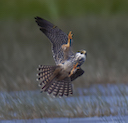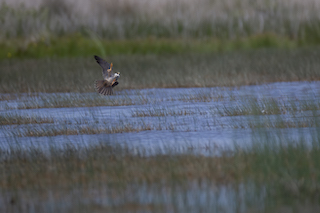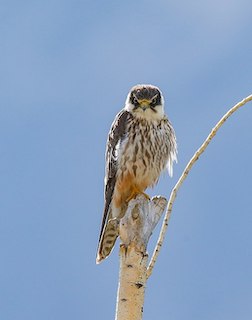 Hobbies fly with such agility and speed, they can even snatch swallows and swifts on the wing. This one was catching a dragonfly over Goonhilly.
Hobbies fly with such agility and speed, they can even snatch swallows and swifts on the wing. This one was catching a dragonfly over Goonhilly.
Photo: © Richard Birchett
Scientific name: Falco subbuteo
Other common names: Eurasian Hobby
UK conservation status: Green: Birds of UK Conservation Concern; Schedule 1, Wildlife and Countryside Act
What to look for:
• Colouring and appearance: Long, narrow wings. Grey upperparts, white underparts strongly streaked with black, white throat, black-brown head, yellow legs and characteristic rusty-red ‘leggings’. The wings are grey above and dark-streaked white beneath.
• Size: Length, 28 to 36 cm; Wingspan, 70 to 92 cm.
• Where: Open farmland, scattered woodland, wetlands and lowland heaths, hunting for prey on the wing from April to September. Found in southern to middle England, as far north as the Humber and Mersey, and Wales.
• Call: Alarm call; adult male call
• Similar species: Peregrine Falcon, but the rust red ‘leggings’ of the Hobby are distinctive.
 Fast-flying and acrobatic, the Hobby is a thrill to see. Swallows and House Martins may not be so keen, though: an agile predator, a Hobby is able, with a bit of luck and good timing, to pursue and catch them in mid-air. These prey birds even have a special alarm call reserved as a warning that a Hobby is about. Hobbies more generally prey on small, slower-flying birds and larger insects, such as dragonflies, grabbing them in their talons and then often staying on the wing, circling slowly as they feast on their meal.
Fast-flying and acrobatic, the Hobby is a thrill to see. Swallows and House Martins may not be so keen, though: an agile predator, a Hobby is able, with a bit of luck and good timing, to pursue and catch them in mid-air. These prey birds even have a special alarm call reserved as a warning that a Hobby is about. Hobbies more generally prey on small, slower-flying birds and larger insects, such as dragonflies, grabbing them in their talons and then often staying on the wing, circling slowly as they feast on their meal.
Hobbies are summer visitors to our shores, migrating to and from their African wintering grounds south of the Sahara. It is, indeed, the only falcon species to overwinter this far south. In the UK, they are extending their distribution northwards, now breeding as far north as the Humber, and with the occasional breeding record for Scotland. They breed in trees, using old nests – such as crow nests – and laying a single clutch of two to three eggs. The female incubates the eggs for up to a month (with occasional egg-sitting duties by the male). After hatching, the young take a further month to fledge, and remain dependent for a further thirty to forty days.
 Did you know…?
Did you know…?
…The species name subbuteo means ‘smaller than a buzzard’ (literally, ‘sub-hawk’). The genus name Falco is from the Latin for ‘sickle, referring to the curved talons found in this genus of birds-of-prey.
…The table football game ‘subbuteo’ was so-called because its designer, Peter Adolph (1916-1994), loved Hobbies: they were his favourite bird.
More information and references:
Svensson, L., Mullarney, K., Zetterstrom, D.,1986. Collins Bird Guide, second edition (translated by Christie, D., Svensson, L.). HarperCollins, London.
Published: June 2020
Author: Amanda Scott
Photos: Hobby in flight, catching a dragonfly: Richard Birchett (website, YouTube channel); Hobby perching: Imran Shah / CC BY-SA
